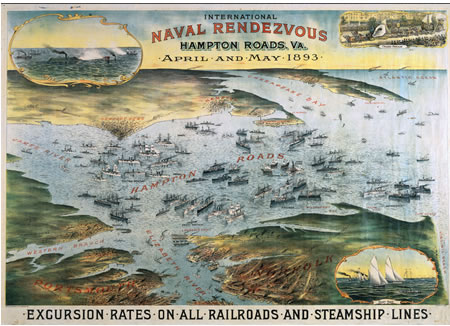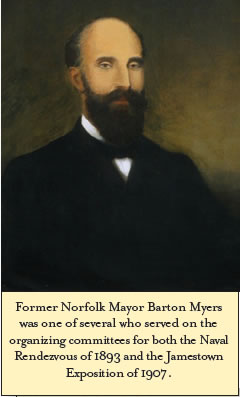
|

Fall 2006 CourierNaval Rendezvous of 1893Next year will be full of celebrations of the 400th anniversary of
the arrival of the Jamestown colonists. Among the events to be remembered
will be the Jamestown Exposition of 1907 which marked the last centenary.
That celebration was a substantial, wellattended
“This is to be the great week in Norfolk’s history. It will be ever known as Rendezvous Week, and the events that will transpire will always occupy a prominent place in the history of this section.” So the Norfolk Virginian described the opening of the now largely forgotten Hampton Roads Naval Rendezvous of April 17-24, 1893. Thirty-eight warships from ten countries were to gather in the spacious harbor as the first of a chain of celebrations leading to the Chicago Colombian Exhibition in what was expected to be the greatest international accumulation of warships since Queen Victoria’s Golden Jubilee of 1887. The idea for the Review came from Col. Alexander A. Anderson who had first suggested a World’s Fair in honor of Columbus. Originally planned for Washington, technical considerations had changed the site of the fair to Chicago and that of the review to New York. Congress passed an enabling act on April 25, 1890 stating “the President is hereby empowered and directed to hold a naval review in New York harbor in April 1893, and to extend to foreign nations an invitation to send ships of war to join the U.S. Navy in rendezvous at Hampton Roads and proceed thence to said review.” Helpful Virginia legislators had amended the original bill to include the Chesapeake Bay gathering. At least 20 nations were invited. Some such as China, Turkey and Uruguay declined as no vessels were available. Haiti was forced to refuse by the fact that it had no navy. For those countries that did accept, the selection of which warships to send became a delicate diplomatic juggling act. When Russia announced it would send five vessels, England promptly added HMS Australia from the Mediterranean station to bring its representation to the same number.
The Naval Rendezvous Association, headed by Col. George W. Johnston
and former Norfolk Mayor Barton Myers, organized the festivities ashore.
In a wistfully remembered show of regionalism, the cities surrounding
Hampton Roads each contributed at least $2500 to pay for maps, fireworks,
boat races, military drills and band concerts. The owners of the four-decked
excursion steamer Columbia offered her for a free trip for Norfolk school
children to view the fleet. Over one hundred businesses from cigar makers
to oyster packers entered By the 17th of April, Hampton Roads began to fill as the British squadron of five ships was joined that afternoon by Dutch and French vessels. Warships would continue to trickle in over the next week. The population of the cities surrounding the Roads swelled by 50,000. Prices soared. “It costs 30 cents to get shaved, and only the wealthiest are able to afford a hair-cut,” lamented the Virginian. Local watermen made small fortunes charging $5 an hour to ferry sight-seers amongst the anchored warships. The Hygeia Hotel at Old Point Comfort turned away enough people to have doubled its occupancy daily. Even bad weather in midweek could not dampen the crowd’s spirits. In the face of high winds, ladies simply sewed lead shot in the hems of their skirts to prevent “an undue display of ankles as they clambered up the steep landing steps of the ships.” The Naval Rendezvous Association had given thought to the needs of the sailors serving in this armada. Special events were organized for their entertainment. Ship’s bands joined in concert. Marine detachments held a competitive drill. The crews of the San Francisco won every boat race held on the 19th. After noting the prize money was only $50, the Virginian’s reporter allowed that “a considerable amount changed hands” in side bets. “The San Francisco’s men have more money than they can spend in a week’s liberty.” The good times came to end at 9 o’clock on the morning of Monday,
24 April. Excursion steamers from as far away as Baltimore and Washington
filled with onlookers to watch the departure of the Rendezvous fleet
on its way to New York. Thousands lined Sewell’s Point, Ocean
View and Old Point Comfort. The warships pulled out in two columns with
American vessels to the left. Following in the rear was a clump of three
Brazilian ships which had arrived only the night before. After the fleet
cleared the Capes, the excursion steamers returned to port. The beautiful
bunting which has bedecked the most imposing buildings in Norfolk has
been removed, and Norfolk’s holiday celebration is over.”
But the Norfolk Virginian rhapsodically predicted
|
You Are Here: Home > Essays and Artifacts > Insights from The Courier > Fall 2006 > Naval Rendezvous of 1893 www.NorfolkHistorical.org |

